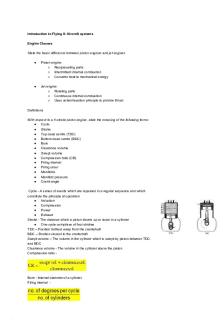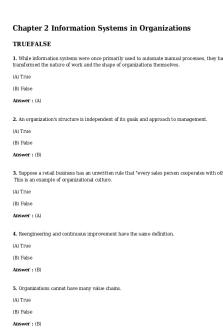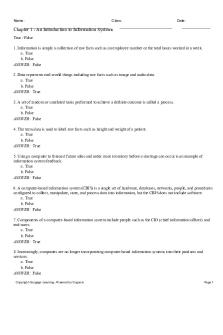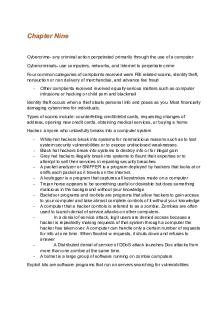Introduction to Sensory Systems PDF

| Title | Introduction to Sensory Systems |
|---|---|
| Author | Salina MANGHLANI |
| Course | Optometry |
| Institution | City University London |
| Pages | 4 |
| File Size | 211.1 KB |
| File Type | |
| Total Downloads | 188 |
| Total Views | 1,007 |
Summary
Introduction to Sensory SystemsMost behaviours can be explained by a reflex arc: Stimulus received by receptor – turns it into neurobiological activity – stimulates the sensory neuron – goes to CNS and signal processed – AP sent down motor neuron to a muscle – contracts and produce a respond.Stimuli...
Description
Introduction to Sensory Systems Most behaviours can be explained by a reflex arc: Stimulus received by receptor – turns it into neurobiological activity – stimulates the sensory neuron – goes to CNS and signal processed – AP sent down motor neuron to a muscle – contracts and produce a respond. Stimuli potentially available to an animal – external. Mechanical (mechanoreceptors) – touch, hearing, balance and acceleration (vestibular). Chemical (chemoreceptors) – taste (gustation) and smell (olfaction) Photic (photoreceptors) – vision (photoreception). Thermal (thermoreceptors) – hot/cold. Pain (nociceptors) Kinestheia (proprioceptors) – muscle spindles. Internal stimuli Mechanical – baroreceptors (stretch receptors in the aortic arch and carotid body). Chemical – blood oxygen/ carbon dioxide. The number of stimuli/sense is even greater if non-number animals are considered. Earth’s magnetic field is perceived by animals such as birds and fish and used for navigation (magnetoreception). Aquatic animals such as fish and some Amphibia have lateral lines have lateral lines (mechanoreceptors) to sense water movements. Sharks can detect fish buried in the sea bed by detecting their electric fields (electroreception). All these sensory receptors convert a sensory stimulus into neurobiological activity (transduction) – a stimulus causes a change in membrane permeability – leads to a receptor potential – causes an action potential which is carried to the CNS. Olfactory receptors are also sensory neuron – odour molecule binds to a receptor; ion channels are opened and an action potential is produced in the receptor and is transmitted to the brain. Most usually – there is a specialised receptor cell that does not generate an action potential – but synapses with a sensory neuron that does. A gustatory
receptor is a specialised receptor cell – produces a small depolarisation only – triggers an action potential in the sensory neuron. The stimulus is quite often modified by an accessory structure (before it acts on receptor cell) – most tactile receptors. The Vestibular System From the basis of our sense of balance and acceleration (unconscious sense). Balance involves many modalities: Tactile receptors in contact with the floor. Vision But without the information about movement and head position provided by the vestibular system – these are insufficient. Important for optometrists – controls aspects of our movements. If head moves one way, eyes move in the other direction to maintain fixation. The ear subserves both the auditory and vestibular systems. Hearing – outer ear channels the sound to the tympanic membrane – whose vibrations are amplified by the bones of the middle ear. Movement of the oval window causes fluid movement in the cochlea of the inner ear which stimulates hair cells by movement of the basilar membrane. Inner ear consists of a bony labyrinth filled with perilymph suspended in which is a membranous labyrinth containing endolymph. Divided into 3 portions: o The cochlea (hearing) Latter two make o Bony vestibular containing the membranous saccule and up the vestibular utricle. system. o 3 semi-circular canals orientated in the 3 planes of space at the end of each canal is an enlargement (ampulla). Structure of vestibular sensory hair cells: o Membranous labyrinth is lined with epithelial cells – in some areas these are modified into sensory hair cells. o The surface of the hair cells contains cilia – one of which is at the side of the cell and is larger (kinocilium). o Base of the hair cell joins a sensory neuron.
o Hair cells are morphologically (kinocilium is on one side) and physiologically polarised. At rest, the afferent/sensory neuron is tonically active – if the stereocilia are bent towards the kinocilium they depolarise and the afferent firing rate increases. If the stereocilia are bent away from the kinocilium, the afferent firing rate decreases. o Bending towards – opens potassium channels (endolymph is rich in potassium) – enters the hair cell and depolarises it. Semi-circular canal hair cells Found in the ampullae and the canal is filled with endolymph. Sit on a ridge/ crest – cilia are embedded in a gelatinous cupula (blocks the canal). All the kinocillia are on the side of the cell facing the vestibular. When the head is still – hair cells are not bent – as the endolymph and skull are not moving. When we turn out heads one way, semi-circular canals will rotate in the same direction. The endolymph will however move in an opposite direction (due to inertia it stays more or less in the same place) – the endolymph will push against the cupula and bend the hair cells. When the head turns lef – the kinocillia in the left canal will be bent. Towards the vestibular (excited) – those on the right will be bent away from the vestibular (inhibited). The canals are responding to angular acceleration. This will not respond to linear motion or constant speed – with constant rotation the endolymph will catch up with the bony labyrinth and hair cells will no longer be stimulated. When rotation ceases – dizziness occurs as relative endolymph movement is reversed.
In the vestibular the hair cells are located in one area in utricle (horizontal here) and one in the saccule (vertical here) – known as maculae – cilia are embedded in a dense otolithic membrane. All the kinocillia in a macula face a striola (imaginary line) – so if all hair cells bend – some will be excited and some inhibited. As the otolithic membrane is heavy tilting the head will impart a shearing force on the macula of the utricle – it therefore detects gravity – form of linear acceleration. Output of the vestibular system reaches the CNS via the VIIIth cranial nerve. Vestibular dysfunction – lesions affecting the 8th cranial nerve – acoustic neuroma. Meneires disease – is an idiopathic condition of the inner ear related to endolymph leakage (hydrops). Labyrinthitis –inflammation of the inner ear following a viral infection....
Similar Free PDFs

Introduction to Sensory Systems
- 4 Pages

Introduction to Digital Systems
- 222 Pages
Popular Institutions
- Tinajero National High School - Annex
- Politeknik Caltex Riau
- Yokohama City University
- SGT University
- University of Al-Qadisiyah
- Divine Word College of Vigan
- Techniek College Rotterdam
- Universidade de Santiago
- Universiti Teknologi MARA Cawangan Johor Kampus Pasir Gudang
- Poltekkes Kemenkes Yogyakarta
- Baguio City National High School
- Colegio san marcos
- preparatoria uno
- Centro de Bachillerato Tecnológico Industrial y de Servicios No. 107
- Dalian Maritime University
- Quang Trung Secondary School
- Colegio Tecnológico en Informática
- Corporación Regional de Educación Superior
- Grupo CEDVA
- Dar Al Uloom University
- Centro de Estudios Preuniversitarios de la Universidad Nacional de Ingeniería
- 上智大学
- Aakash International School, Nuna Majara
- San Felipe Neri Catholic School
- Kang Chiao International School - New Taipei City
- Misamis Occidental National High School
- Institución Educativa Escuela Normal Juan Ladrilleros
- Kolehiyo ng Pantukan
- Batanes State College
- Instituto Continental
- Sekolah Menengah Kejuruan Kesehatan Kaltara (Tarakan)
- Colegio de La Inmaculada Concepcion - Cebu











![OBrien - Introduction to Information Systems [2010]](https://pdfedu.com/img/crop/172x258/zx28ke2j06rw.jpg)

